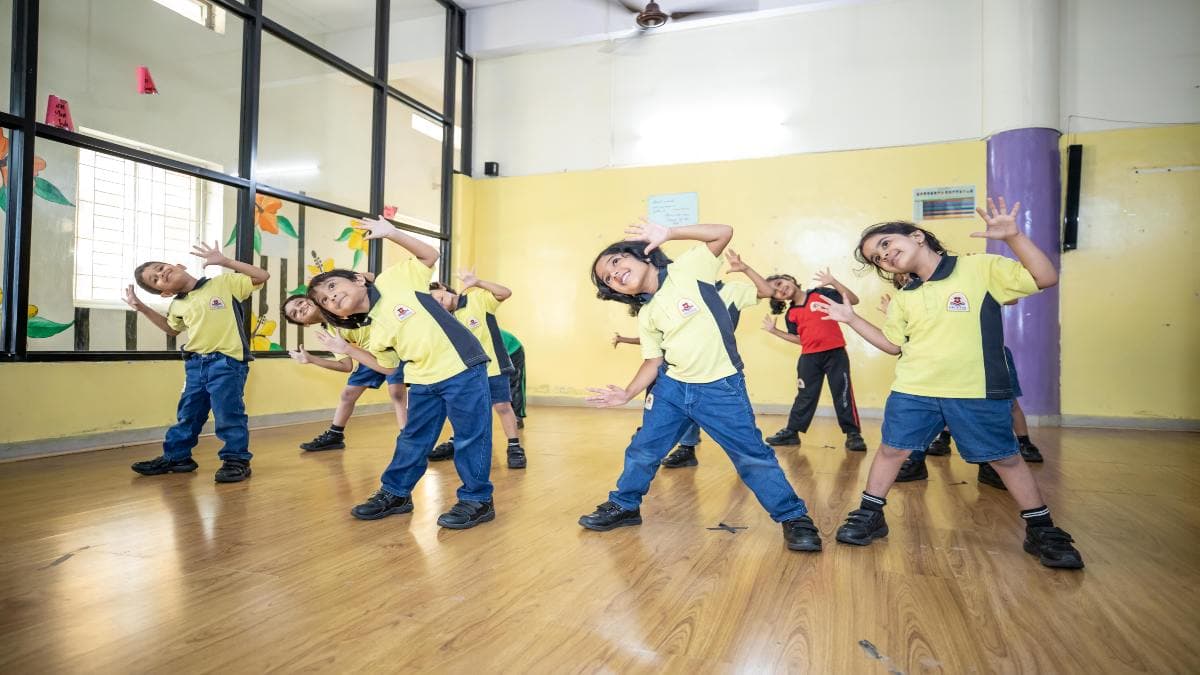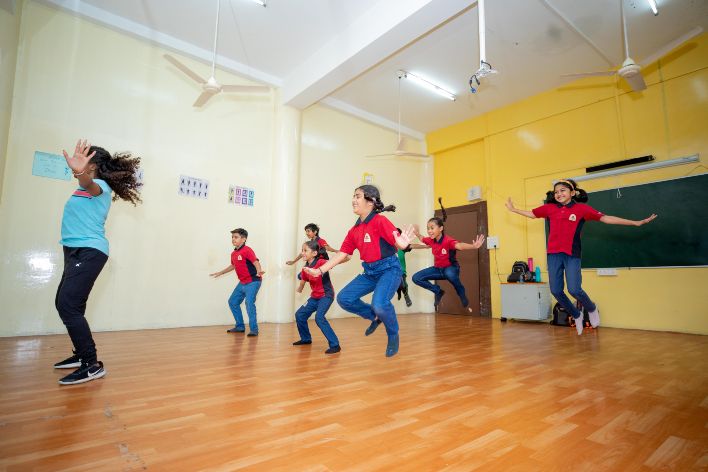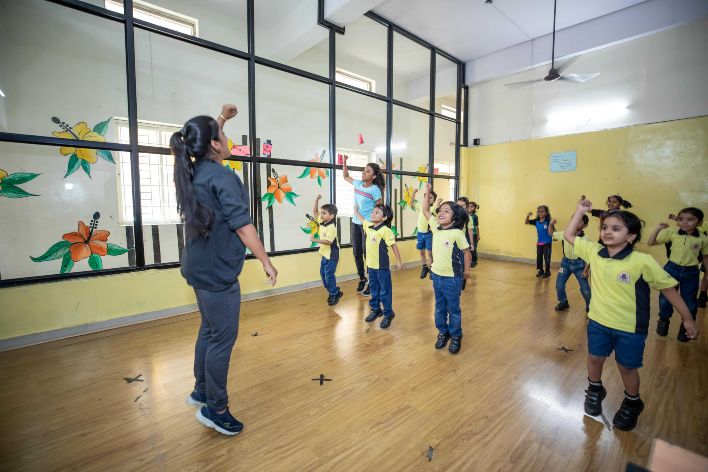Music and Dance Movement for kids: A parent’s guide
By Pinkey Sharma |
Date 07-08-2024

Table of Contents
Admissions Open for
As a parent, you are passionate about your children's' affairs. You want them to be healthy, happy, and whole. One way of doing this is introducing your school-going kids to the world of dance and movement. From physical health to emotional well-being, dance can foster all-round development in children by allowing them the expression of self-potential in different forms. Here is an all-inclusive guide to dance advantages, dance forms, routines, choreography tips, and every other support process inspiring your kids toward embracing this wonderful art form.
The Advantages of Dance
More than just the performing art, dance is a holistic undertaking that gives children many benefits. Here are some key benefits of dance for kids:
1. Physical Health Benefits
Dancing is a great exercise for cardiovascular health, flexibility, strength, and endurance. Unlike traditional sports, dance involves a range of muscle groups, coordination, and most importantly, balance enhancement. Regular exercise through dance helps children keep a healthy weight, makes their bones strong, and raises their overall levels of fitness. Different types of dance can make children target different parts of their body to ensure that kids have well-rounded physical development. For example, ballet makes posture and grace better in children, hip-hop increased agility and stamina, while tap dance improved timing and rhythm.
2. Opens Up a Child's Emotional and Mental Condition
Dance is such a powerful tool for expressing oneself. It lets children blow off steam, work out tension, and sometimes let go of stress. This will build confidence, hence self-esteem, hence competence. It also makes rhythmic movements capable of driving music into a mood state capable of stress relief and life-affirming buoyancy. Some dance styles, such as contemporary or jazz, may be totally therapeutic because they focus on emotional expression and on conveying messages or telling stories by movement.
3. Social Skills and Teamwork
The major part of dance classes is about practice, during which kids will need to cooperate, communicate, and work in team mode. Rudimentarily, the kids get to know how to do something together, with regard to space and respect for one another. They also make friends with children who share a similar interest and bond; it's thus important for their sense of belonging or community among their age-mates. In learning partner dances like ballroom or salsa the children get to learn further regarding cooperation, trust, and etiquette.
4. Cognitive Development
Dance supports cognitive development in children, given that sequences, patterns, choreographies are all taught in children through the art of dancing. The activity supports such development processes of memory, concentration, and problem-solving skills. Creativity in dancing enhances critical thinking and imagination, which translates into work skills beneficial for academic performance. Cultural awareness can also be achieved when exposing children to various dance styles because they can be able to learn quite a number of cultural narratives and histories, which would enrich either cognitive or cultural understanding.
5. Cultural Awareness
Dance opens up the horizons of a child's vision toward different types of cultures and traditions. When children learn these different dance styles, it provides them a way of appreciating and knowing different and numerous things in the world. Therefore, this exposure and cultural understanding in the long run result in tolerance, empathy, and a feeling of being a global citizen. For instance, flamenco can be learned to get a real taste of the elements of Spanish culture, while African dance explains the richness of several tribes under the same big tribe known as Africa.
Learning Exotic Dance Forms
The world of dance is vast, with a great variety of styles and forms to appeal to all interests and abilities. Of these, the following are perhaps the most well-known forms of dance that children can do:

1. Ballet
Hip-hop is a dance form that is often less structured and more improvisational. This style uses the body in the rhythmic and percussive movements of an urban environment. Hip-hop is a great way for kids to be expressive while developing confidence and coordination. Classes are lively and full of energy, and students have the opportunity to express themselves individually.
2. Hip-Hop
Hip-hop is a vibrant, energetic form of dance that originated from urban communities. It has many facets, including breaking, popping, locking, and freestyle. It allows and encourages one to be expressive, creative, and unique. It's intriguing for children because they are able to remain active and be engaged in today's popular music and culture in a fun manner. Some of the popular hip-hop dances that excite children are the Moonwalk and the Dougie.
3. Jazz
Dancers tend to say that 'jazz dance is one of the fun genres in dance,' although this would annoy other dancers of a different discipline. This dance form can literally be credited with improvisation and fluidity. Jazz is also the style of dance responsible for bringing performance to dance; noting anything that would allow performance to be so boring in an empty room. Children in a jazz class learn rhythm, flexibility, and how to relate to music. The free interpretative style of jazz makes it rather versatile. Jazz styles can range from Broadway jazz to street jazz, each one employing its own specific techniques and flair.
4. Tap Dance
A percussive dance form, tap dance involves the use of tap shoes to create rhythms and sounds. The emphasis is placed on the footwork, timing, and rhythm established within the dance. Classes teach students coordination and balance, as well as audition skills. The rhythm of tap dancing can be fun and interactive for children. There are a number of famous tap routines, such as those done by Gene Kelly or Fred Astaire, which you can use to open students' minds to their future possibilities as tap dancers.
5. Contemporary
Contemporary dance is a free, loose form that encompasses modern, ballet, and jazz elements. The form emphasizes natural movements, expressions of emotions, and narratives more than anything else. There are a lot of children who express their creativity through dancing in many ways: connecting their feelings with their bodies and interpreting music in their own ways. It is only through dance that many children can express their creativity through their bodies, feel their emotions, and interpret music in so many different ways. Famous contemporary works, such as those by Martha Graham or Alvin Ailey, can illustrate how deep and versatile this dance form is.
6. Ballroom
Ballroom dancing is a way of dancing with partners. The styles are waltz, tango, foxtrot, and cha-cha. It offers the teaching of grace, poise, and coordination with the partner. The class teaches kids all about social etiquette, partnership, leading, and following. It is great for the child to learn social skills and will definitely enhance confidence. Ballroom competitions like "Dancing with the Stars" might actually open up the wonders of sophistication and thrill in these very dances.
7. Folk and Cultural Dances
Folk and Cultural dances are traditional dances representative of the respective country and region. Such dances may have historical elements and may be infused with some cultural background. Thus, learning this category of dances may endear the students to appreciate and understand their heritage or that of some other cultures. For example, Irish step dance, Indian classical dance, and Brazilian samba—all having rich cultural narratives and unique movements.
Dance Routines and Choreography for the Kids
For the young kids, choreographing a routine and being able to do it both at the same time is the entire dance process. The following are tips that can be used in teaching the children on how to come up with their routines and improve the hand in choreography:
1. Start with the Simple Moves
Basic, simple moves for beginners. Newbies should first be given basic, simple moves for them to grasp since it is easy to follow given it is simple. Remember, these are beginners so they must be taught basic and uncomplicated steps to get themselves acclimated. As soon as they are already at ease with the basics, then is the time you can slowly integrate the complicated steps.
2. Repetition
Repeating the same routine over and over again can be helpful, obviously, because the kids can easily commit to memory their routines; thus, practicing these many times will build muscle memory that can greatly add to their confidence.
Choose music that suits the dance style and that the child enjoys. The right music can increase their performance experience and make the choreography more interesting.
3. Let them Emote
Get children to express well in the piece; it is essential to portray the theme and message. Emoting depthens the performance and gets the audience interested.
4. Have them Do Different Genres
Experiment with movements from different dance styles to create something new. Sometimes, a mix of two genres will not only be more exciting but can also reveal the dancer in a new light.
5. Add Some Props
Props like scarfs, hats, or ribbons can add that element of surprise into the routine and deck the performance out visually.
6. Focus on Transitions
Smooth transitions between moves are important to ensure a perfect performance. Teach children to focus on the flow and transition smoothly from doing one step to another.
7. Encourage Improvisation
Improvisation allows one to come up with creative moves and, in turn, a distinctive style. Encourage children to improvise on some parts of their routine to find some moves.
8. Recording and Review
By videoing the dance practices, kids can observe back and see for themselves which are the many areas of improvement. This will lead them to strictly take action on those points and progress in performance. This will also make them realize their progress over time.
10. Feedback
Constructive feedback from the instructor, peers, family members helps the child to get insightful information which can help them work on their routine.
Fun Dance Activities for Kids
With added elements of fun dance activities, the process of learning dance can make your kids acquire the concepts naturally with no strain. Below are some of the fun dance activities to incorporate in learning sessions.

This way, it's a fun-filled and animated game, where children choreograph to music and freeze in their steps when the music dies. It is a very good way for the kids to improve their levels of listening and to move forward with the glands of coordination and balance. This motivates the kids toward creativity by coming up with new dance moves while playing.
1. Animal Dance
Animal Dance involves children making the leaping steps of an animal like a rabbit during hopping, a snake during sliding, or an elephant at times during stamping. This allows children to be creative, active, and at the same time know different kinds of animals.
2. Ribbon Dancing
In Ribbon dance, children dance in sort of a follow-the-leader type choreography with ribbons to shape and pattern the air. This gives a very creative activity, enhancing coordination and flexibility, and gives a visual component of dance. It also helps in the exploration of rhythm and movements.
3. Follow the Leader
In the game Follow the Leader, one child leads a dance routine, and the others imitate. Leadership skills of the children, cooperation, and eliciting creativity are taught using the game. At the same time, children improve with their dance skills, as they have to look at movements made and try to imitate them.
Scarf Toss is an interesting dance that needs the children to catch the scarves by throwing them in the air. This activity brings out the hand-eye coordination, balance, and timing of a person. The colorful scarves used add so much fun and make the dance engaging in a visual manner.
4. Hokey Pokey
The Hokey Pokey is quite a famous children's song and dance where the participants get to follow some lyrics that instruct the participants to move different parts of their bodies in and out of a circle. It is known to have a catchy chorus and playful moves.
5. Musical Chairs
This game makes children dance around chairs to the tune of music. When the music goes off, children are supposed to sit on a chair. This game enhances listening and quick-thinking skills and further improves coordination.
6. Balloon Volleyball
In the past, kids used to keep a balloon in the air by hitting it when dancing. It teaches children how to work in a group, coordination, and physical fitness. Since the balloon is floating, it's easy for any kid and not boring as such.
7. Simon Says
Simon Says is a children's game in which one child dictates the dance that should follow, and others follow only if the order began with "Simon says". This is one of the ways to improve listening and coordination, as well as using directions to improve motor skills.
8. Dance Along Videos
Dance-Along Videos Online, in essence, are those dance videos that take one through fun and easy steps for dancing. They give step-by-step instructions for children, whereby children can easily acquire new movements at individual paces. They cover different dancing styles, making the entire process lively and exciting.
Encouraging Professional Dance Training
Though recreational dance classes are a nice way for you to introduce the activity to children, professional dance training is a good way to uplift their activity. Here are ways through which children can be encouraged to pursue professional dance training:
1. Look for Dance Schools
Find credible dance schools or studios to know whether they offer professional studies. Go further to get details about their programs, faculty, and facilities to know whether they do offer quality education.
2. Open Houses
Attend open houses or make a point of taking trial classes to have a feel of the environment in the school as well as the type of models of teaching style around. This will enable you to know whether it is the ideal place for your child.
3. Support their passion
Support and give a complete boost to the passion that your child has embraced in pursuing dance by attending their performances, most importantly towards the necessary equipment, and desist from harboring any negative sight towards their training.
4. Set realistic goals
Enable your child to set realistic goals with regard to dance training — that is, achieving particular techniques, taking part in competitions, or pursuing dance as a career.
5. Offer a Balanced Schedule
Make sure your child has a balanced schedule that allows for dance training, study, and leisure. This way, they will avoid burnout and will be able to continue their activities with no less passion for dance.
6. Teach the Child to Persevere
Although the professional dance training is rigorous, he himself is going to be demanding of his own. Encourage your child to be committed, work hard, and embrace the learning process.
7. Positive Environment
Make your home environment positive and supportive of your child's development as a dancer. Appreciate their accomplishments and, in case of need, inform them on their weaknesses.
Conclusion
Dance and movement are a perfect introduction to the world of the physical, emotional, and social development of a school-age kid. With so many advantages and beneficial factors, beginning from physical fitness to emotional benefit, one can always be found dispensing things that talk about creativity and expression. A fun and dance-related physical activity process fosters an encouraging atmosphere for the pursuit of lifetime joy in dance and overall development.
Celebrate the progress that your child has made, encourage their creativity, and be supportive of the passion they have. Whether they want to be professional dancers or simply love the art of movement, the benefits dance offers will fill their lives. Embrace the world of dance and movement, and watch your child flourish into a confident, expressive, and well-rounded individual.
FAQs related to dance and movement for kids
What is dance and movement?
Dance and movement involve rhythmic and expressive physical activities performed to music, allowing individuals to convey emotions and tell stories through motion.
What are the benefits of dancing and movement?
Dancing improves physical fitness, coordination, and flexibility while also enhancing emotional well-being, self-confidence, and social skills.
What is a fun fact about dance for kids?
A fun fact about dance for kids is that hip-hop dance originated in the streets of New York City and includes playful moves like the "Moonwalk."
Why is dancing a good activity for children?
Dancing is great for children because it promotes physical health, boosts creativity, fosters social connections, and provides a fun way to express themselves.
Liked what you read? Feel free to share this article with your friends and spread the knowledge!
Related blogs:
Music and Dance Movement for kids: Discover amazing activities and tips in our extensive guide to dance for kids!
Choose the Right Dance Style for Your Child: Explore the perfect dance style for your child with our expert tips. Explore now!
Dance Training for Kids: Discover the costs associated with kids' dance training in India, including monthly fees, hidden charges.
CBSE Schools In Popular Cities
- CBSE Schools in Bangalore
- CBSE Schools in Mumbai
- CBSE Schools in Pune
- CBSE Schools in Hyderabad
- CBSE Schools in Chennai
- CBSE Schools in Gurgaon
- CBSE Schools in Kolkata
- CBSE Schools in Indore
- CBSE Schools in Sonipat
- CBSE Schools in Delhi
- CBSE Schools in Rohtak
- CBSE Schools in Bhopal
- CBSE Schools in Aurangabad
- CBSE Schools in Jabalpur
- CBSE Schools in Jaipur
- CBSE Schools in Jodhpur
- CBSE Schools in Nagpur
- CBSE Schools in Ahmednagar
- CBSE School In Tumkur

Call Us to know more about Orchids
Swipe Up



.jpg&w=1920&q=80)












